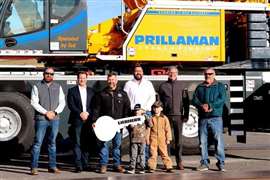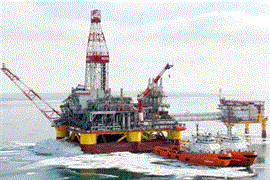Take your pick
25 April 2008

Sales of all terrain cranes worldwide continue to grow and the AT has become the crane of choice in the majority of mobile crane rental fleets. IC estimates the 2005 world total new AT market at around 2,800 units, about 10% higher than 2004. Fastest growing is the 100 tonne class with an estimated 20% of the total, approaching double its 2004 share.
In the 80 to 120 tonne capacity range strong sales are accompanied by launches from several manufacturers in the last year. Strong competition between manufacturers (which means a wider choice for buyers) is well illustrated in this capacity class. The most recent example is 100 tonners on four axles, where Terex-Demag and Grove both announced such machines at the Intermat exhibition in Paris earlier this year.
Grove announced its new four-axle AT, the GMK4100 (GMK4115 in the US). It is a new design, Grove says, and has a 52 m six-section Megaform boom with Twin-Lock pinning. A 10 to 17 m bi-fold swingaway jib is available, and two additional 5 m inserts further increase jib length. Maximum tip height is 82 m.
The carrier's drive is 8x6x8 as standard including independent rear and crab steering. An 8x8x8 drive is an option. The carrier is powered by a 295 kW Mercedes-Benz engine, while the Mercedes transmission provides 16 forward and two reverse gears, combined with a two stage transfer box. On the superstructure power comes from a four-stroke, direct fuel injection Mercedes-Benz OM 904 LA diesel engine rated at 110 kW (147.5 hp).
The GMK4100 can travel below 12 tonnes per axle with 6.3 tonnes of counterweight, together with the bi-fold swingaway jib, a 16 tonne hook block, and riding on 16.00 R25 tyres. Maximum counterweight is 26.1 tonnes.
The new 100 tonne capacity Terex-Demag is the AC 100/4. The four axle AT will be seen in iron for the first time at the Bauma exhibition in Germany next year. It will have a five-section 50 m pinned boom for a strong lifting chart. At a 10 m radius with the boom fully extended, the preliminary chart shows it will lift 12 tonnes. Maximum boom and jib combination will be 69 m. On 16.00 R25 tyres the carrier will be 2.55 m wide and 10.3 m long. Overall length, including the boom overhang, will be 13.1 m.
Some of the smaller manufacturers have released new models in the busy 100 tonnes capacity class. Luna in Spain unveiled the first production version of its new 90 tonne capacity model – the AT90/58 – earlier this year after showing a prototype at the SMOPyC exhibition in March 2004.
The manufacturer claims that the AT90/58's 58 m boom, which can be extended to 79 m with the addition of an 18 m offsettable jib, is the longest in its class.
A strong lifting chart, especially in the 5 to 16 m radius range, is a primary feature of the crane, Luis Mur, Luna export manager, told IC. At 10 m radius, with 20 tonnes of counterweight and the boom extended to 42.9 m, the chart shows a lifting capacity of 18 tonnes through 360 degrees. Set the same but with 4 tonnes of counterweight, capacity is still 15.6 tonnes.
The four axle AT-90/58 runs at 12 tonnes per axle with 16.00 R25 tyres, 1 tonne of counterweight and hook block. The operator cab can be tilted by up to 20 degrees to give the operator a better view and the crane has the manufacturer's own fully integrated CAN Bus-based electronic system with full in-cab information display.
On future developments, Mur told IC that Luna will consider further extending its range upwards by designing a five axle 140 or 150 tonne capacity AT later this year.
A new addition in the 80 tonne capacity class is the redesigned 80 T-TT from Italian manufacturer SCM. Kessler axles and a Wabco anti-lock braking system (ABS) have been added to improve stability and safety.
The 80 T-TT, which is designed to be particularly suitable for the erection of pre-fabricated structures, has a 42 m main boom, which can be increased to 62 m with the addition of an offsettable jib. SCM says that the 80 T-TT is “simpler and cheaper than competing models” and that ease of operation and maintenance were at the forefront of the design process.
Another new 80 tonner is the Grove GMK4080-1, a replacement for the 75 tonne capacity GMK4075-1. The GMK4080-1 will pick 6.6 tonnes with its six section Twin-Lock Megaform boom fully extended to 51 m and set at a radius of 20 m. With hydraulic luffing jib and 6 m extension, maximum tip height is 75 m.
The GMK4080-1 can be configured in 'Taxi' or 'Maxi' modes. In Taxi mode, it is within 12 tonnes per axle with 9.3 tonnes of counterweight, 15 m hydraulic swingaway, 16 tonne hook block and 16.00 R25 tyres. In Maxi configuration, capability is increased by an extra 6 m hydraulic swingaway insert and counterweight to a maximum of 19.3 tonnes. Eight counterweight configurations are possible, from 1.8 up to the maximum.
Features carried over from the GMK4075-1 include the ZF AS-Tronic transmission and 290 kW Mercedes-Benz OM 501 LA engine. Front overhang on the new model, at 1,800 mm, is 263 mm less than its predecessor and total length is 12.5 m, which is 265 mm shorter than the outgoing model.
Light pickers
Further down the capacity scale in the 60 tonnes and under category, there are also new models. With new truck mounted cranes already available from Terex-Demag and similar models under development at Liebherr and Tadano Faun, buyers will face an interesting choice when deciding which cranes to buy in the 60 tonnes and under class.
Whatever buyers decide, Terex Demag will be offering both options to customers. The company has upgraded its 55 tonne capacity AC 55 to AC 55-1, with improvements that include a new boom telescoping system that reduces the axle loads and enhances lifting capacity. With the boom telescoped to 40 m and set at 10 m radius, the increase in lifting capacity over the outgoing model is more than 20%, Terex-Demag says.
Telescoping and setup times of the AC 55-1's fully hydraulic boom are 50% shorter than with a pinned boom, the manufacturer claims, and the boom can be telescoped under load. A further benefit is lower weight, which reduces front axle load – the crane will run at 12 tonnes per axle on 16.00 tyres, with 5.15 tonnes of counterweight, 15 m main boom extension and hook blocks, the manufacturer says.
Lifting capacity is increased the most (by between 10 and 20%) on longer combination lengths at medium operating radii. A new option is an 8 or 15 m hydraulically offsettable boom extension that can be controlled from the operator cabin under full load.
From Liebherr, the two axle LTM 1040-2.1 fits into the AT range between the 35 tonne capacity LTM 1030-2.1, also on two axles, and the 45 tonne three axle LTM 1045-3.1.
The new crane has a 35 m, four-section single cylinder boom that can be telescoped under partial load. Fitting the 9.5 m swing away jib increases maximum under hook height to 44 m. As an alternative to the smaller LTM 1030-2.1, the new LTM 1040-2.1 has a 5 m longer boom and lifting capacity is an average of 7% stronger, the manufacturer says.
On the road overall length is 10.52 m and the carrier is 8.38 m long and 2.5 m wide. At 12 tonnes per axle the overall weight of 24 tonnes includes 1.5 tonnes of counterweight and the swing away. Power is from a 205 kW Mercedes-Benz turbo diesel driving through an automatic ZF transmission with torque converter.
Liebherr's last 40 tonne capacity ATs were the three axle LTM 1040, built from 1989 to 1994, later upgraded to LTM 1040/1, followed in 2002 by the 45 tonne LTM 1045/1, now designated LTM 1045-3.1. Grove launched its two axle 35 tonne capacity GMK2035E, a version of the GMK2035, at the Intermat exhibition in April. It has the same capacity rating and the same 29 m boom but, instead of the Megatrak independent suspension system, it has conventional rigid axles and hydrogas springing. Another difference from the existing GMK2035 is that the E version has a manually offset jib while the hydraulically luffing version is an option.
Manufacturer's view
While buyers consider their options with the latest wave of launches, the mood among manufacturers is buoyant. Shinichi Iimura, president of Japanese- owned all terrain crane manufacturer Tadano Faun in Germany says there are hot markets for all terrains everywhere, highlighting Europe, the Middle East, the US and Japan. In all these markets demand has been strengthening for the last two years and is gathering momentum, “We could see signs of the trend increasing in mid-2005,” Iimura says. “At the moment it is booming everywhere,” Iimura continues, “but, in the next five years, there will be a downtrend in some areas.”
China and Russia are very interesting markets and will be in the next demand cycle, as will India, Iimura says.
In general, interest will increase in the AT type product while RT and truck crane demand will remain constant as these two crane types are popular in many large markets, Iimura says, and that the proportion of ATs in all markets has been increasing.
“In most [European] territories and outside the EU we are growing market share. Our latest products are very well accepted, especially the 160 and 65 tonne capacity models.”
Hans-Georg Frey, managing director at Liebherr-Werk Ehingen, is confident that all terrain development will continue in the face of competition from other types of crane, “I think that in the past we have seen that the all terrain crane has very much replaced rough terrains and truck cranes but not 100%. All three types of crane have their right to exist – there are areas where each type is the ideal machine. I think there are still more markets where the all terrain will substitute rough terrains or truck cranes.
If you look at, for example, Spain, a market that not too long ago had few all terrains, now has almost only AT cranes, which is a good example of how the AT concept has replaced the other two types of machine. As I said, however, it will not be 100% replacement as there are still applications where an RT would be the better type of machine or where a truck crane would be best.


